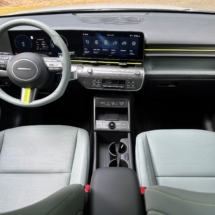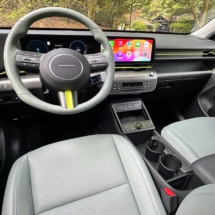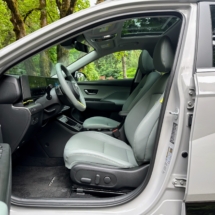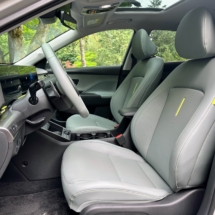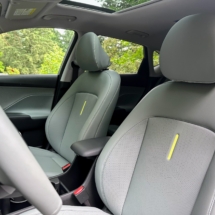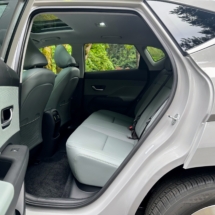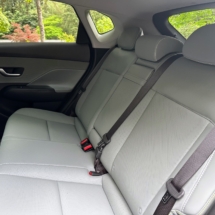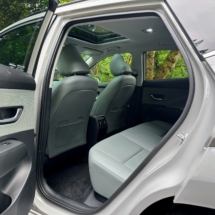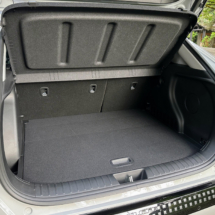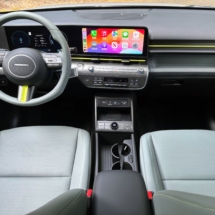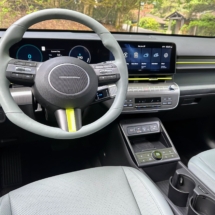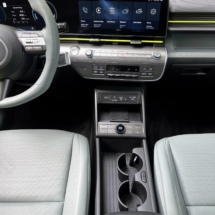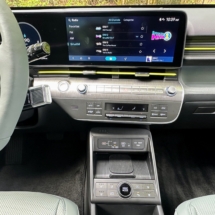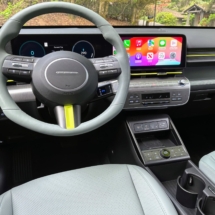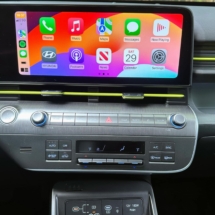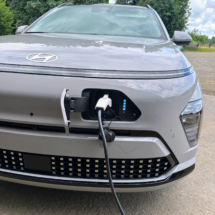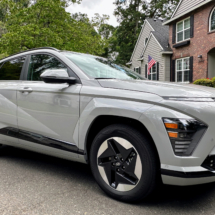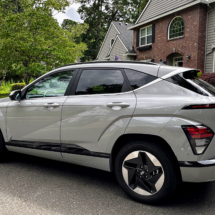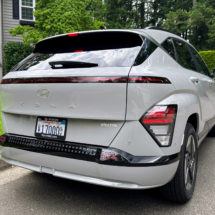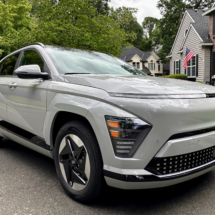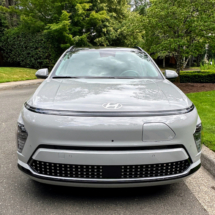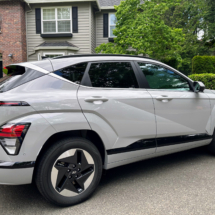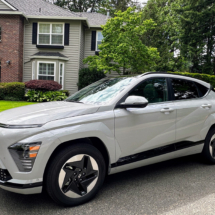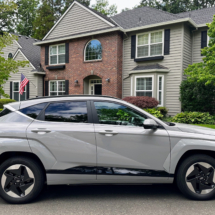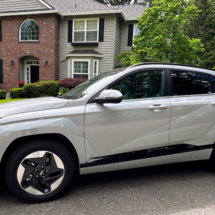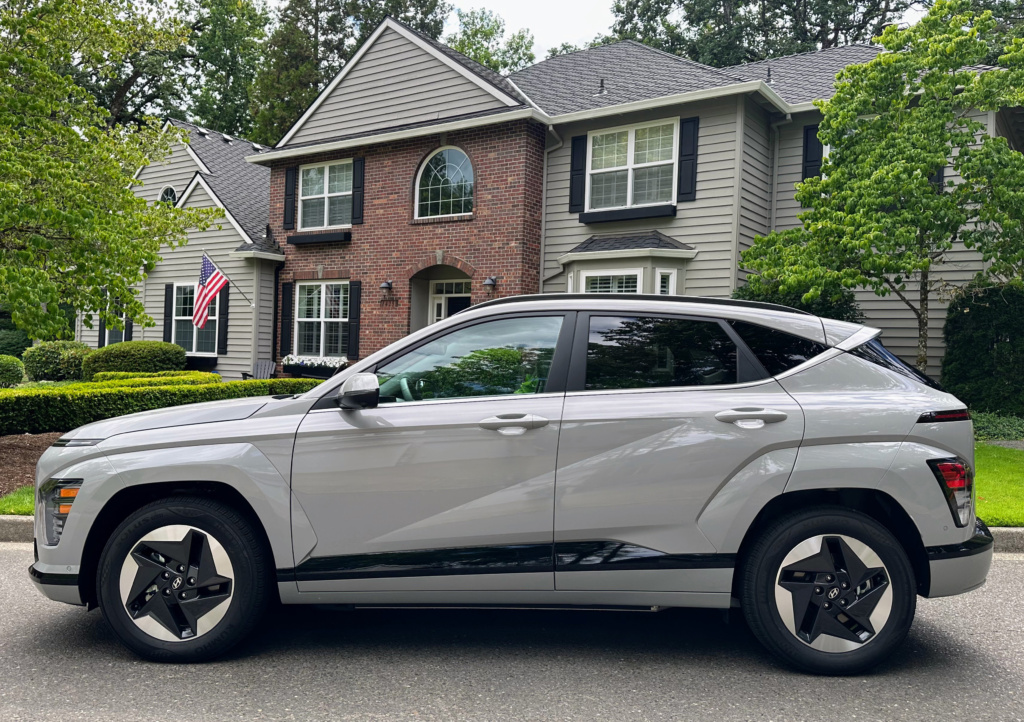
Are you looking for a practical and well-rounded small electric vehicle that won’t break the bank? The 2024 Hyundai Kona Electric has a lower sticker price than many EVs but has a decent range, smooth ride, many standard features, lots of cargo space, and stylish looks. While it’s not perfect, the Kona EV offers good value for the money.
Base Price: $$41,045
As Tested: $42,630
Horsepower: 201
Mileage: 129 MPGe city/103 MPGe highway/116 MPGe combined
The 2024 Kona Electric is the littlest EV made by Hyundai, fitting in the line-up below the Ioniq 5 SUV and Ioniq 6 sedan. It has room for five passengers, although the second row is suitable for two instead of three adults.
The Kona Electric was introduced for the 2019 model year. For 2024, it gets totally redesigned and is now in its second generation. It’s longer and wider with more passenger and cargo space, gets a larger battery, and has a slightly better range than the outgoing model. There’s also a gas-powered Kona which was also redesigned for 2024.
The 2024 Kona Electric comes in three trims: SE, SEL, and Limited. Starting prices are $32,675, $36,675 and $41,045, respectively, which are relatively low for a small electric SUV. Front-wheel drive is standard; all-wheel drive isn’t available.
Two powertrains are available. The SE trim gets a 99-kW electric motor and 48.6-kWh lithium-ion battery. Total output is 133 horsepower and 188 pound-feet of torque. The other two trims get a 150-kW electric motor and 64.8-kWh lithium-ion battery that produce 201 horses and 188 pound-feet. The transmission on all trims is a single speed automatic.
The gear selector has been moved from the center console to a stalk behind the steering wheel. This helps open up the front area and provides more space for cupholders so you can bring your huge coffee mug!
The 2024 Kona Electric isn’t exhilarating to drive but it’s pleasant and easy. As with most EVs, acceleration is energetic from a stop and when speeding up to merge and pass on the freeway. The ride is smooth on all but the bumpiest roads. Steering is responsive but with light feedback. The Kona Electric corners well with the battery providing a low center of gravity. The tight turning radius makes it easy to squeeze into tight parking spaces.
As with most electric vehicles, the Kona Electric has a one-pedal driving mode that lets you accelerate, decelerate and stop by using only the accelerator pedal. You can adjust the level of regenerative braking with paddle shifters on the steering wheel.
The base SE trim has a driving range of 200 miles and EPA ratings of 131 MPGe (miles per gallon equivalent) city and 105 MPGe highway with a combined rating of 118 MPGe. The SEL and Limited trims get more range at 261 miles but slightly lower efficiency at 129 MPGe city and 103 MPGe highway with a combined rating of 116 MPGe.
While these ranges aren’t as large as some higher-priced rivals, they are decent for daily driving and shorter road trips.
I managed to get about 300 miles per charge if I drove conservatively – no jackrabbit starts and stops – and minimized use of AC.
Charging the Kona Electric can take less time than other EVs, but charging times aren’t as quick as some other Hyundai EVS. With a Level 2 / 240-volt outlet, the SE battery can go from 10% to 100% charge in just under 5 hours, while the SEL and Limited trims take just over six hours. Hyundai says the battery can go from a 10% to 80% charge in 43 minutes with Level 3 / DC fast-charging. You can also charge with a regular 120-volt household plug, but this will only add 3-4 miles of range per hour.
The charging port is conveniently located on the front of the vehicle.
The 2024 Kona Electric also has a V2L function (vehicle-to-load) which means you can charge your various electric gadgets including e-bikes, lights and tools, and you can also use it to power your house when there’s a power outage.
The cabin is nicer than the outgoing model but not as upscale as some rivals. It has a clean and modern look. There are some hard plastics, as you expect at this price point, but also many soft-touch materials. The Kona Electric gets the same digital display and infotainment set-up as some spendier Hyundai models with a 12.3-inch digital driver display and 12.3-inch touchscreen. Front row passengers have decent leg- and headroom. The backseat is a bit tight but will accommodate two average-size adults. A nice feature for second row passengers is that the rear seats recline. And the rear floor is flat – there’s no hump in the middle which makes for extra legroom.
Standard features include remote keyless entry, proximity keyless entry, remote start, push-button start, rearview camera, dual-zone automatic climate control, cloth upholstery, six-way manually adjustable driver’s seat, 12.3-inch digital instrument cluster, infotainment system with 12.3-inch touchscreen, navigation, six-speaker audio system, HD Radio, satellite radio, wireless Android Auto and Apple CarPlay, Bluetooth, four USB ports, Wi-Fi hot spot, and automatic high-beam headlights
Available features include a surround-view camera system, auto-dimming rearview mirror, synthetic leather upholstery, eight-way power-adjustable driver’s seat, heated front seats, ventilated front seats, leather-wrapped steering wheel, heated steering wheel, eight-speaker Bose audio system, wireless device charging, ambient interior lighting, universal garage door opener and a sunroof.
Standard driver assistance technologies include forward collision warning, forward automatic emergency braking, stop-and-go adaptive cruise control, lane-keep assist, lane-centering assist, lane-change assist, blind-spot monitoring, traffic-sign recognition, rear cross-traffic alert, driver-attention monitoring, rear-seat alert, and vehicle exit warning (alerts passengers exiting the vehicle of other vehicles approaching from behind).
Available driver assistance technologies include front and rear parking sensors and park assist
The infotainment system looks great with its large 12.3-inch touchscreen. Graphics are sharp, menus are logically arranged, and the system responds quickly to touch and voice inputs. Several physical knobs and buttons make it easy to adjust common functions such as audio and climate.
Cargo space is generous for a small EV. There are 25.5 cubic feet with both rows of seating in place and 63.7 cubes with the second row folded. A hands-free power liftgate is available. The frunk (front trunk) is tiny at just .95 cubic feet but it is big enough to house the charging cord.
The warranty is great – the Kona Electric gets Hyundai’s five-year/60,000-mile limited warranty, 10-year/100,000-mile battery warranty and 10-year/100,000-mile powertrain warranty.
The good:
Stylish looks
Decent range
Relatively low starting price
Ample passenger and cargo space
Good value for the money
Many standard features
Standard wireless Android Auto and Apple CarPlay
The not-so-good:
Interior not as upscale as some rivals
Small frunk
All-wheel drive not available
Pricing info:
My tester starts at $41,045. Carpeted floor mats are $210. Delivery fee is $1,375 bringing the grand total to $42,630.
Bottom line:
The redesigned 2024 Hyundai Kona Electric stands out among small electric SUVs for its value, decent range, easy-to-drive nature, roomy cabin, standard features, and distinctive styling.


